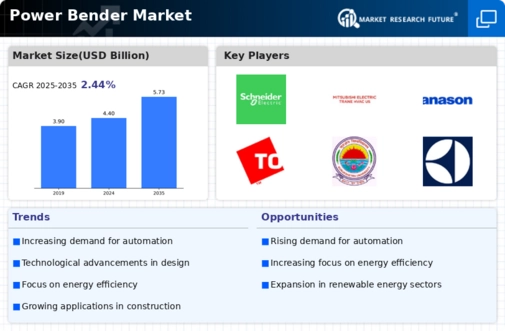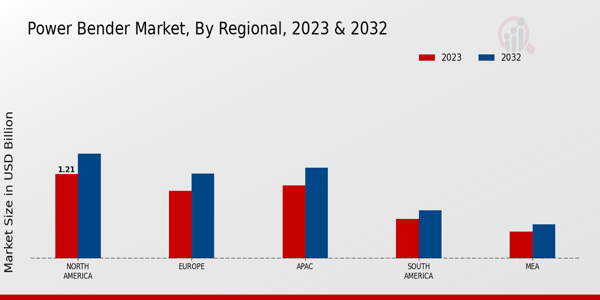Technological Advancements
Technological innovations play a pivotal role in shaping the Global Power Bender Market Industry. The introduction of advanced materials and smart technologies enhances the performance and efficiency of power benders. These advancements not only improve operational capabilities but also extend the lifespan of equipment. As a result, manufacturers are increasingly investing in research and development to create cutting-edge solutions that meet evolving consumer needs. This focus on innovation is expected to contribute to the market's growth, with projections indicating a rise to 5.73 USD Billion by 2035, highlighting the potential for continued expansion driven by technological progress.
Growing Industrial Applications
The Global Power Bender Market Industry is experiencing increased adoption across various industrial sectors. Industries such as manufacturing, construction, and energy are recognizing the benefits of power benders in enhancing operational efficiency and reducing downtime. The versatility of power benders allows for their application in diverse processes, leading to improved productivity and cost savings. As industries continue to expand and modernize, the demand for reliable and efficient power bender solutions is likely to rise. This trend underscores the market's potential for growth, as businesses seek to optimize their operations through innovative technologies.
Emerging Markets and Global Expansion
Emerging markets are becoming increasingly significant in the Global Power Bender Market Industry. As economies in regions such as Asia-Pacific and Latin America continue to develop, the demand for power bender solutions is expected to rise. These markets present opportunities for manufacturers to expand their reach and tap into new customer bases. The growth of infrastructure projects and industrialization in these regions is likely to drive the adoption of power benders, contributing to the overall market expansion. The increasing focus on modernization and efficiency in emerging economies suggests a promising outlook for the industry.
Increasing Demand for Energy Efficiency
The Global Power Bender Market Industry is witnessing a surge in demand for energy-efficient solutions. As industries and consumers alike strive to reduce energy consumption and lower utility costs, power benders are increasingly viewed as essential tools. In 2024, the market is projected to reach 4.4 USD Billion, reflecting a growing recognition of the importance of energy efficiency in various sectors. This trend is further supported by government initiatives promoting sustainable practices and energy conservation, which are likely to drive the adoption of power benders across multiple applications.
Regulatory Support for Sustainable Practices
Regulatory frameworks promoting sustainability are significantly influencing the Global Power Bender Market Industry. Governments worldwide are implementing policies aimed at reducing carbon emissions and encouraging the adoption of energy-efficient technologies. These regulations create a favorable environment for the growth of power bender solutions, as businesses seek to comply with environmental standards. The alignment of market offerings with regulatory requirements not only enhances competitiveness but also fosters consumer trust. As a result, the market is poised for steady growth, with a projected CAGR of 2.42% from 2025 to 2035, indicating a robust trajectory driven by regulatory support.
























Leave a Comment